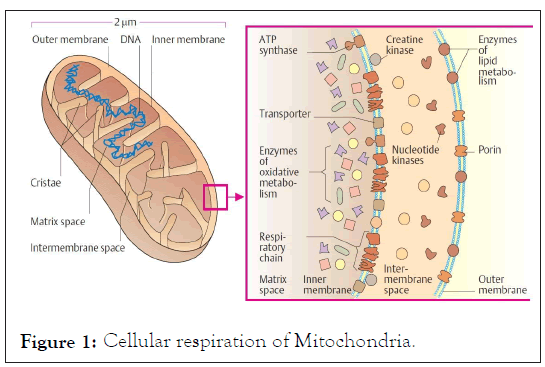Journal of Cell Science & Therapy
Open Access
ISSN: 2157-7013
ISSN: 2157-7013
Editorial - (2021)
Mitochondria are the cell's energy generators. They are digestive organelles that take in nutrients, break them down, and produce energy rich compounds for the cell. Cellular respiration is the name given to the cell's metabolic processes. The mitochondria are the sites of many of the processes that occur during cellular respiration. Mitochondria are the energy producing organelles in cells. Mitochondria are tiny organelles that float around freely inside cells. Some cells have thousands of mitochondria, while others don't. Because muscle cells require a lot of energy, so they have loads of mitochondria. Mitochondria can sometimes enlarge or merge with other mitochondria (Figure 1).

Figure 1: Cellular respiration of Mitochondria.
• Mitochondria are surrounded by two membranes: a smooth outer membrane and a tubular or folded inner mitochondrial membrane with a substantial surface area that encloses the matrix region.
• Cristae are the folds in the inner membrane, while tubules are the tube-like protrusions.
• Between the inner and outer membranes, there is an intermembrane gap.
• The number and structure of mitochondria, as well as the number of cristae on them, varies greatly between cell types.
• Tissues with a high rate of oxidative metabolism, such as heart muscle, have mitochondria with a high number of cristae.
• The form of mitochondria can vary even within one type of tissue, depending on their functional condition
• Mitochondria are mobile, plastic organelles.
• Mitochondria most likely evolved from aerobic bacteria in association with primitive anaerobic eukaryotes during an early stage of evolution.
• This endo symbiont theory is supported by many findings. For example, mitochondria have a ring shaped DNA (four molecules per mitochondrion) and have their own ribosomes. The mitochondrial genome became smaller and smaller during the course of evolution.
• In humans, it still contains 16,569 base pairs, which code for two rRNAs, 22 tRNAs, and 13 proteins.
• Only these 13 proteins (mostly subunits of respiratory chain complexes) are produced in the mitochondrion.
• The mitochondrial envelope consisting of two membranes also supports the endosymbiont theory.
• The former symbiont's inner membrane has a structure similar to that of prokaryotes.
• It has a unique lipid called cardiolipin but very little cholesterol.
• Both mitochondrial membranes are very rich in proteins.
•Small molecules can be exchanged between the cytoplasm and the intermembrane gap thanks to porins in the outer membrane.
•Even small molecules cannot get through the inner mitochondrial membrane (with the exception of O2, CO2, and H2O).
• The inner membrane contains many transporters that ensure the import and export of essential metabolites.
• Respiratory chain complexes, ATP synthase, and other enzymes are also transported across the inner membrane.
• The matrix is also rich in enzymes.
• The mitochondria's most crucial role is to produce energy.
• Nutritional molecules that are simpler are delivered to the mitochondria for processing and production of charged molecules.
• When these charged molecules come into contact with oxygen, they form ATP molecules. Oxidative phosphorylation is the name for this process.
• Mitochondria assist cells in maintaining correct calcium ion concentrations inside cell compartments.
• Mitochondria also help in the formation of certain blood components and hormones such as testosterone and oestrogen.
• Ammonia detoxifying enzymes are found in the mitochondria of liver cells.
• The mitochondria also play important role in the process of apoptosis or programmed cell death.
• Abnormal death of cells due to the dysfunction of mitochondria can affect the function of organ.
Citation: Citation: Afrin A (2021) A Brief Discussion about Mitochondria. J Cell Sci Therapy.S6:e320.
Received: 10-Sep-2021 Accepted: 24-Sep-2021 Published: 01-Oct-2021 , DOI: 10.35248/2157-7013.21.s6.e320
Copyright: © 2021 Afrin A. This is an open-access article distributed under the terms of the Creative Commons Attribution License, which permits unrestricted use, distribution, and reproduction in any medium, provided the original author and source are credited.